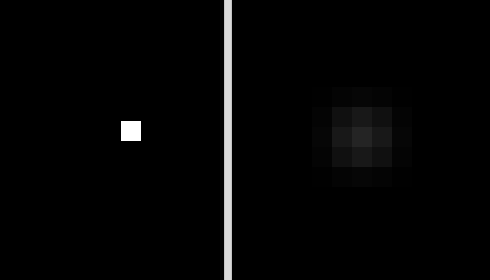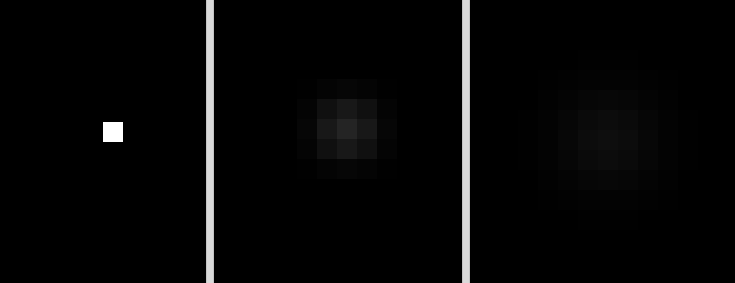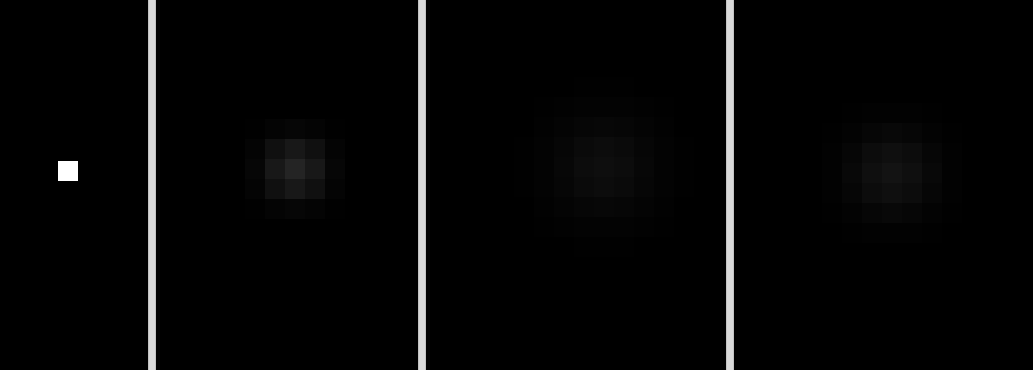《学习OpenCV》练习题第五章第二题abc
代码:
#include <stdio.h>
#include <opencv/highgui.h>
#include <opencv/cv.h>
#include <opencv_libs.h> /*
*《学习OpenCV》第五章第二题
* 完成时间:21:43 10/13 星期日 2013
* 作者:qdsclove@163.com
*/ /* Image Size */
#define IMG_SIZE 100 /*
* Window Title
*/
#define WNDTITLE_IMAGE "source image"
#define WNDTITLE_FIVE "5*5 Gaussian"
#define WNDTITLE_NINE "9*9 Gaussian"
#define WNDTITLE_FIVE_TEICE "5*5 Gaussian Twice" /*
* function: calculate MSE & PSNR of two GrayScale(8-bit depth & one channel) images.
* param: img1 -- the first image.
* param: img2 -- the second image.
* param: dMSE -- the MSE of two images(output)
* param: dPSNR -- the PSNR of two images(output)
* return: 0 -- success; others -- failed.
*/
int calculateGrayImgsPSNR(IplImage* img1, IplImage* img2, double& dMSE, double& dPSNR)
{
if( !img1 || !img2 ||
img1->nChannels != ||
img2->nChannels != ||
img1->depth != img2->depth ||
img1->width != img2->width ||
img1->height != img2->height )
{
return -;
}
int width = img1->width;
int height = img1->height; // calculate MSE of the two images
double dSumOfSquares = ;
for(int i = ; i < height; i++)
{
char* pdata1 = img1->imageData + i * img1->widthStep;
char* pdata2 = img2->imageData + i *img2->widthStep;
for(int j = ; j < width; j++ )
{
uchar value1 = *(pdata1 + j);
uchar value2 = *(pdata2 + j); double square = pow( (double)(value1 - value2), );
dSumOfSquares += square;
}
} dMSE = dSumOfSquares / (width * height); // this is means the two images are strictly same.
if(dMSE == )
{
dPSNR = -;
return ;
}
int iDepth = img1->depth;
int iMAX = pow( ., iDepth) - ; dPSNR = * log10(iMAX / (sqrt(dMSE))); return ;
} int main()
{
IplImage* image = cvCreateImage( cvSize(IMG_SIZE, IMG_SIZE), IPL_DEPTH_8U, );
IplImage* dst_five_gaussian = cvCreateImage( cvGetSize(image), image->depth, image->nChannels );
IplImage* dst_nine_gaussian = cvCreateImage( cvGetSize(image), image->depth, image->nChannels );
IplImage* dst_twice_five_gaussian = cvCreateImage( cvGetSize(image), image->depth, image->nChannels ); // 全部像素置零
cvZero(image);
// 设置中心像素为255
cvSet2D(image, IMG_SIZE/, IMG_SIZE/, cvScalarAll()); // 5*5 高斯滤波
cvSmooth(image, dst_five_gaussian, CV_GAUSSIAN, , );
// 9*9 高斯滤波
cvSmooth(image, dst_nine_gaussian, CV_GAUSSIAN, , );
// 5*5高斯滤波 第二次
cvSmooth(dst_five_gaussian, dst_twice_five_gaussian, , ); cvNamedWindow(WNDTITLE_IMAGE, CV_WINDOW_NORMAL);
cvNamedWindow(WNDTITLE_FIVE, CV_WINDOW_NORMAL);
cvNamedWindow(WNDTITLE_NINE, CV_WINDOW_NORMAL);
cvNamedWindow(WNDTITLE_FIVE_TEICE, CV_WINDOW_NORMAL); cvShowImage(WNDTITLE_IMAGE, image);
cvShowImage(WNDTITLE_FIVE, dst_five_gaussian);
cvShowImage(WNDTITLE_NINE, dst_nine_gaussian);
cvShowImage(WNDTITLE_FIVE_TEICE, dst_twice_five_gaussian); cvSaveImage("source.bmp", image);
cvSaveImage("5_5_gaussian.bmp", dst_five_gaussian);
cvSaveImage("9_9_gaussian.bmp", dst_nine_gaussian);
cvSaveImage("5_5_gaussian_twice.bmp", dst_twice_five_gaussian); // c part
double dMSE = , dPSNR = ;
calculateGrayImgsPSNR(dst_nine_gaussian, dst_twice_five_gaussian, dMSE, dPSNR);
printf("9*9 GAUSSIAN & 5*5 GAUSSIAN Twice: MSE: %f\tPSNR: %f\n", dMSE, dPSNR); cvWaitKey(); cvReleaseImage(&image);
cvReleaseImage(&dst_five_gaussian);
cvReleaseImage(&dst_nine_gaussian);
cvDestroyAllWindows(); return ;
}
结果分析,这里的截图都是结果图像放大之后的结果:
原图 & 5*5高斯滤波后的图像:

原图 & 5*5高斯滤波后的图像 & 9*9高斯滤波后的图像:

c部分:
原图 & 5*5高斯滤波后的图像 & 9*9高斯滤波后的图像 & 两次5*5高斯滤波后的图像:

9*9平滑一次与5*5平滑两次的MSE与PSNR:

从上一篇博文(http://www.cnblogs.com/qdsclove/p/3366907.html)可知这两幅图像的相似度很高。
《学习OpenCV》练习题第五章第二题abc的更多相关文章
- 《学习OpenCV》练习题第五章第一题ab
这道题是载入一幅带有有趣纹理的图像并用不同的模板(窗口,核)大小做高斯模糊(高斯平滑),然后比较用5*5大小的窗口平滑图像两次和用11*11大小的窗口平滑图像一次是否接近相同. 先说下我的做法,a部分 ...
- 《学习OpenCV》练习题第四章第二题
#include <highgui.h> #include <cv.h> #pragma comment (lib,"opencv_calib3d231d.lib&q ...
- 《学习Opencv》第五章 习题6
这是第五章 习题5.6的结合版,其中实现了摄像头抓拍功能,能够成功运行. #include "stdafx.h" #include "cv.h" #includ ...
- 《学习OpenCV》练习题第四章第一题b&c
#include <highgui.h> #include <cv.h> #pragma comment (lib,"opencv_calib3d231d.lib&q ...
- 《学习OpenCV》练习题第四章第一题a
#include <highgui.h> #include <cv.h> #pragma comment (lib,"opencv_calib3d231d.lib&q ...
- Introduction to 3D Game Programming with DirectX 12 学习笔记之 --- 第五章:渲染流水线
原文:Introduction to 3D Game Programming with DirectX 12 学习笔记之 --- 第五章:渲染流水线 学习目标 了解几个用以表达真实场景的标志和2D图像 ...
- JavaScript DOM编程艺术-学习笔记(第五章、第六章)
第五章: 1.题外话:首先大声疾呼,"js无罪",有罪的是滥用js的那些人.js的father 布兰登-艾克,当初为了应付工作,10天就赶出了这个js,事后还说人家js是c语言和s ...
- C primer plus 练习题 第五章
1. #include <stdio.h> #define MINU 60 int main() { int minute, hour, m; printf("请输入分钟:&qu ...
- C++ Primer Plus学习:第十五章
第十五章 友元.异常和其他 友元 友元类 表 0-1 class Tv { public: friend class Remote; } Remote类可以使用Tv的数据成员,Remote类在Tv类后 ...
随机推荐
- kettle创建资源库
手动修改一下这个表 R_VERSION INSERT INTO R_VERSION(ID_VERSION, MAJOR_VERSION, MINOR_VERSION, UPGRADE_DATE, IS ...
- 将Android Studio工程导入到Eclipse中
1.前言 studio项目中src/main/java目录里面的代码对应的是eclispe项目中的src目录中的代码. 而studio中src目录里面包括整个项目的所有代码包括资源文件和xml. 2. ...
- [HDOJ1078]FatMouse and Cheese(记忆化搜索)
题目链接:http://acm.hdu.edu.cn/showproblem.php?pid=1078 题意:给出n, k,然后给出n*n的地图,(下标0~n-1),有一只老鼠从(0,0)处出发,只能 ...
- SQL[连载3]sql的一些高级用法
SQL[连载3]sql的一些高级用法 SQL 高级教程 SQL SELECT TOP SQL SELECT TOP 子句 SELECT TOP 子句用于规定要返回的记录的数目. SELECT TOP ...
- 《OD大数据实战》驴妈妈旅游网大型离线数据电商分析平台
一.环境搭建 1. <OD大数据实战>Hadoop伪分布式环境搭建 2. <OD大数据实战>Hive环境搭建 3. <OD大数据实战>Sqoop入门实例 4. &l ...
- Linux Kernel CMPXCHG函数分析
原文地址:http://blog.csdn.net/penngrove/article/details/44175387 最近看到Linux Kernel cmpxchg的代码,对实现很不理解.上网查 ...
- Spring3.1新特性介绍
Spring3.1新特性 一.Spring2.5之前,我们都是通过实现Controller接口或其实现来定义我们的处理器类. 二.Spring2.5引入注解式处理器支持,通过@Controller ...
- cURL: PHP并发处理方式
function classic_curl($urls, $delay) { $queue = curl_multi_init(); $map = array(); foreach ($urls as ...
- 20160131.CCPP体系详解(0010天)
程序片段(01):Test.c+NewTest.c 内容概要:题目测试 ///Test.c #define _CRT_SECURE_NO_WARNINGS #include <stdio.h&g ...
- nodejs简单层级结构配置文件
在NodeJS中使用配置文件,有几种比较不错的方案:第一种:文件格式使用json是毋容置疑的好方案.格式标准,易于理解,文件内容读取到内存之后,使用JSON的标准分析函数即可得到配置项.第二种:将配置 ...
